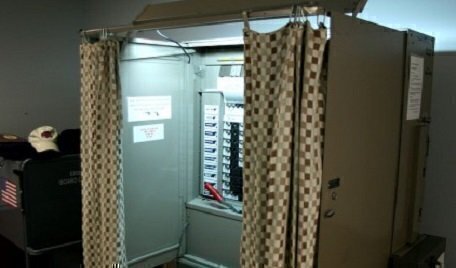Does the First Amendment protect messages on clothing people wear when casting their votes at polling places? That’s a complicated question the Supreme Court will answer sometime this month.
 The under-the-radar dispute from Minnesota law regulating “political” clothing worn at polling places is one many people can identify with. In Minnesota Voters Alliance v. Mansky, Andrew Cilek of Hennepin County was temporarily stopped from voting because he was wearing a T-shirt with a “Don’t Tread on Me” and a Tea Party slogan, and a button endorsing Voter ID policies.
The under-the-radar dispute from Minnesota law regulating “political” clothing worn at polling places is one many people can identify with. In Minnesota Voters Alliance v. Mansky, Andrew Cilek of Hennepin County was temporarily stopped from voting because he was wearing a T-shirt with a “Don’t Tread on Me” and a Tea Party slogan, and a button endorsing Voter ID policies.
Polling officials flagged Cilek for violating Minnesota Statute Section 211B.11, which prevents voters from wearing political badges, political buttons, or other “political insignia” at polling places, because the messages communicated are “designed to influence and impact voting” or promote a “group with recognizable political views.”
Cilek has argued that his rights were violated because the law is “facially overbroad under the First Amendment” because it “broadly bans all political apparel at the polling place.” In particular, the law gives local poll judges wide latitude to determine polices that ban political speech at the polls – in the form of political clothing.
On its way to the Supreme Court, a district court dismissed Minnesota Voters Alliance v. Mansky, in part citing a 1992 Supreme Court decision, Burson v. Freeman. In that 5-3 decision, Justice Harry Blackmun found that that the state of Tennessee had the right to establish a “restricted zone around polling places” as “necessary to serve the interest in protecting the right to vote freely and effectively.”
A divided Eighth Circuit appeals court upheld the lower court decision, relying on the Burson decision and three decisions from other federal circuit courts. But in their appeal to the Supreme Court, the attorneys for the petitioners noted that two other federal appeals courts, the Fourth Circuit and the Seventh Circuit, found that a broad ban on political speech at the polls conflicts with the First Amendment.
At Supreme Court oral arguments on February 28, the Justices asked many questions, and court observers didn’t have a clear sense of the case’s outcome.
David Breemer, arguing for the Voters Alliance and Cilek, faced questions from Chief Justice John Roberts about the state’s rights to ensure a peaceful environment inside the polling place. He asked Breemer if voters should be allowed to “have a time for some quiet reflection or to do that important civic obligation in peace and quiet without being bombarded by another campaign display.” Other Justices pressed Breemer on what rules he would define narrowly to ensure the government could regulate the polling place without violating free speech rights.
The Justices also had pointed questions for Daniel Rogan as he argued the state of Minnesota’s case. Roberts seemed skeptical that Minnesota’s law could regulate some dress items. “Do you really think if someone has a shirt with the tiniest little logo or inscription here, that that's going to have any effect on decorum?” he told Rogan. Justice Samuel Alito seemed equally skeptical when Rogan said a “well-know” message related to an electoral choice could be subject to regulation; the Justice asked if a T-shirt with the text of the Second Amendment could also be banned at the polls.
Also mentioned during arguments was that nine other states have broad bans on political clothing at polls that could be affected by the Court’s decision, which is expected by the end of June.
Scott Bomboy is the editor in chief of the National Constitution Center.







